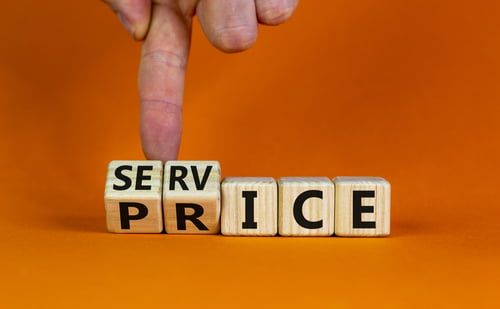
When someone starts a landscaping business, one of the things that they have trouble doing is setting thier lawn care pricess. Pricing for a business has always been a challenge for me. I feel like I have finally figured it out and would like to share my methods with you.
First, I will give you the shortcuts (1, 2, and 3), as I know that’s what you want. But at the end of the day, it all will boil down to the old rule of supply and demand (4), which is the most accurate and best way to price your services.
4 Tips for Setting Your Lawn Care Prices
1) Charge 3x the average hourly rate you pay your labor (shortcut)
This rule of thumb says that you should charge your customer 3x what you pay your help. For my company with my actual numbers, in 2014 we charged about 2.58x what we paid our help.
Example: Your foreman makes $12 an hour, and the guy helping him makes $10 per hour, your average hourly rate is $11 per hour. 3x this hourly rate is $33/hour. So this rule of thumb says that if the numbers above hold true for your company, you should charge your customer $33 per hour.
The idea here is that 2x your labor should cover all the direct costs of producing the work, and 1x your labor should cover your overhead and profit.
2) Charge 2x your costs (shortcut)
The typical landscaping company makes around a 50% gross margin which is where this rule of thumb comes from. To make a 50% gross margin, you need to be charging 2x your costs. This has proven roughly accurate for my company.
Example: Mulch job costs you $25 in material and $75 in labor = $100 total cost to you.
This rule of thumb says you should charge your customer $200. Why? Because $200 revenue – $100 expenses = $100 gross margin = 50%.
These rules of thumb will generally hold true, but as you grow you will need to analyze more deeply to become more competitive. Because you may want to charge 3x your labor or 2x your costs, but for a particular service, the market may not bear this price and you will lose the job. So you will have to know how little you can afford to charge while still making money.
3) Charge what your competition charges (shortcut)
This, in other words, is charging solely by DEMAND. This is by far the easiest approach, especially if you don’t have the experience to know how long something takes, and this approach will work in the beginning. BUT you must eventually figure out the other half of the supply and demand equation, which is your COSTS (discussed below). Without considering your costs, this approach is dangerous.
If your competition is still in business, chances are what they are charging will work for you in the beginning. They know how much they need to charge at a minimum to still make money. If you don’t know what to charge then charging what the competition charges is a good place to start.
How do you know what the market will bear? Easy. Call a few local companies and ask for quotes at your own house or a neighbor. They have already figured this out.
4) Charge a healthy balance of your actual costs and what the market will bear (the best way)
In my opinion, the best approach is a delicate balance of two questions, and everything ends up coming down to the golden rule of supply and demand:
1) What pricing will the market bear for my services? (See 1 above)
2) What do I need to charge for my services?
OK. So say you know that your customer is willing to pay a maximum of $30 for you to mow their lawn. You need to know if you will be making a profit on this property.
Labor is always the biggest expense. So in the beginning, it might cost you less than $5 to mow a lawn in fuel and wear and tear. So you think you are making a $25 profit, right? WRONG. Right now your time may be “free,” but down the road, you will have an employee doing your job so that is where your head needs to be if you ever want to grow.
If that lawn takes one employee 2 hours to mow @ $10 per hour, the cost to you after your payroll taxes is going to be $25 if you assume a 25% payroll burden. Add $5 of fuel and wear and tear, and your cost to mow that property is $30.
If your cost to mow the property is $30, will you be willing to charge your customer $30? I hope not! If so you will never stay in business.
If you need a 10% profit margin, you need to charge them a minimum of $33 for that property. That customer is going to need to either pay more, or you won’t work for them. Supply needs to meet demand.



